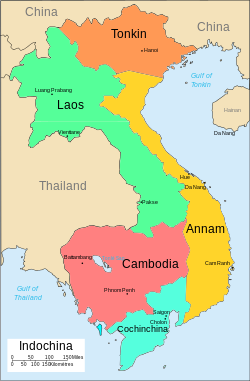French Cochinchina
| French Cochinchina | ||||||||||
| Cochinchine française | ||||||||||
| Colony of France Constituent territory of French Indochina |
||||||||||
|
||||||||||
|
||||||||||
|
Cochin-China was the southern part of present-day Vietnam, shaded cyan
|
||||||||||
| Capital | Saigon | |||||||||
| Languages |
Khmer Cham Chinese French Vietnamese |
|||||||||
| Religion |
Buddhism (Theravada and Mahayana) Confucianism Taoism Roman Catholicism Animism |
|||||||||
| Political structure | Colony | |||||||||
| Historical era | New Imperialism | |||||||||
| • | Established in accordance with Treaty of Saigon | 5 June 1862 | ||||||||
| • | Merged to the Central Government | 4 June 1949 | ||||||||
| Area | ||||||||||
| • | 1868 | 65,478 km² (25,281 sq mi) | ||||||||
| Population | ||||||||||
| • | 1868 est. | 1,214,141 | ||||||||
| Density | 18.5 /km² (48 /sq mi) | |||||||||
| • | 1939 est. | 4,484,000 | ||||||||
| Density | 68.5 /km² (177.4 /sq mi) | |||||||||
| Currency | French Indochinese piastre | |||||||||
|
||||||||||
| Today part of |
|
|||||||||
| a. Population figure taken from P. Gubry, Population et développement au Viêt-nam (2000), p. 44. | ||||||||||
French Cochinchina, or Nam Kỳ, was a colony of French Indochina, encompassing the Cochinchina region of southern Vietnam.
For a series of complex reasons, the French government of Napoleon III, with the help of Spanish troops arriving from the colonial Philippines in the Spanish East Indies, invaded the southern part of Vietnam, then known in the West as Cochinchina. In September 1858, France occupied Đà Nẵng (Tourane). On 18 February 1859, they conquered Saigon and three southern Vietnamese provinces: Biên Hòa, Gia Định and Định Tường; the Vietnamese government was forced to cede those territories to France in June 1862.
The southernmost part of Vietnam, which was until called by the French lower Cochinchina (Basse-Cochinchine) became a colony known as Cochinchina.
In 1867, the provinces of Châu Đốc, Hà Tiên and Vĩnh Long were added to French-controlled territory. In 1864 all the French territories in southern Vietnam were declared to be the new French colony of Cochinchina, which would be governed by Admiral Marie Jules Dupré from 1871 to 1874.
In 1887, it became part of the Union of French Indochina. Unlike the protectorates of Annam protectorate and Tonkin protectorate, Cochinchina was ruled directly by the French, both de jure and de facto, and was represented by a deputy in the National assembly. Together with Tonkin, it was one of the economic centers of French Indochina.
...
Wikipedia



